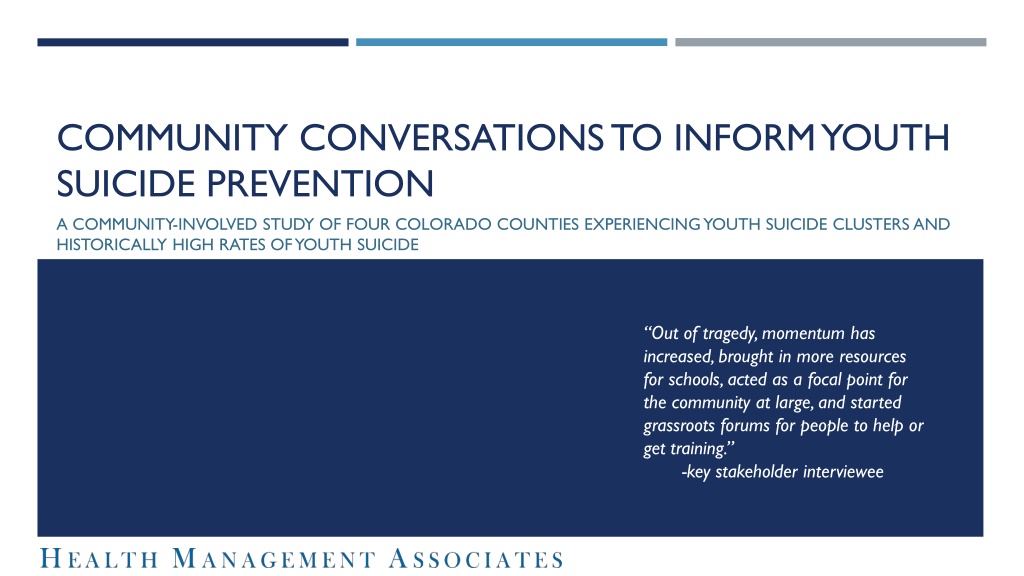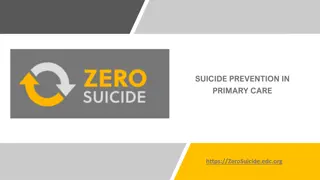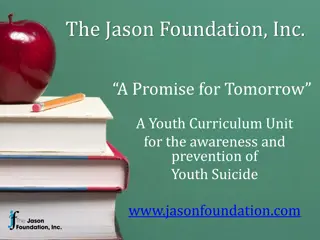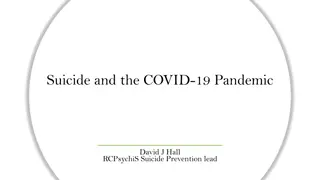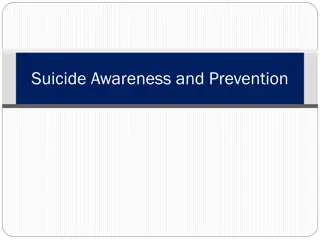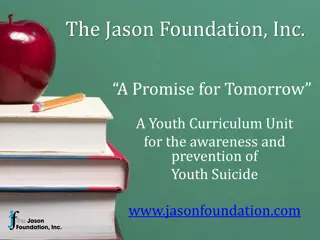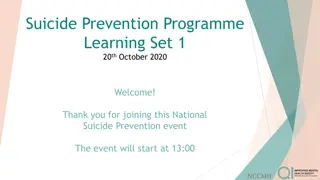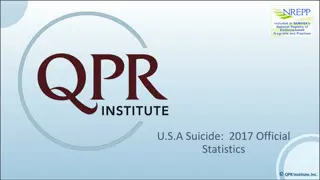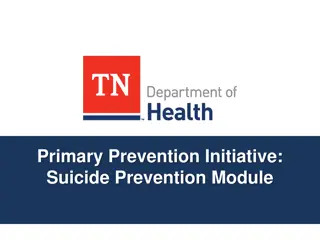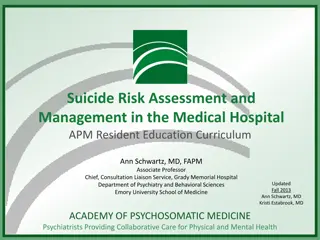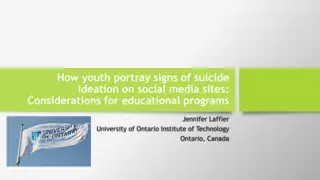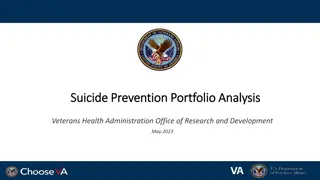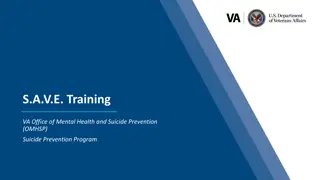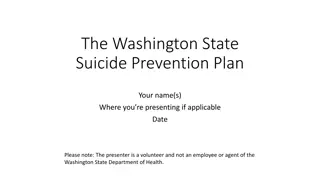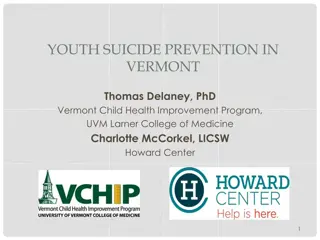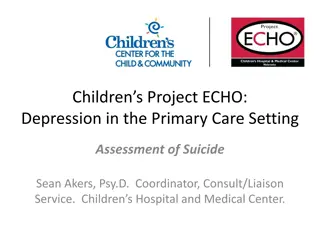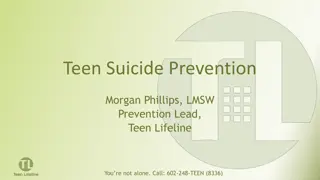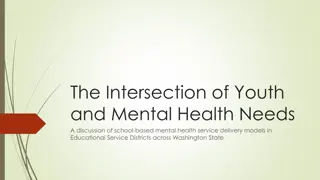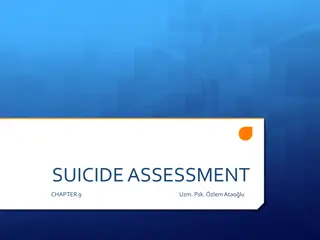Understanding Youth Suicide Prevention Efforts in Colorado
A community-involved study in four Colorado counties experiencing youth suicide clusters and high rates of suicide has led to increased resources, grassroots forums, and support for suicide prevention. Key stakeholders were interviewed, and data was analyzed to inspire support and drive resource targeting. The study involved multiple approaches such as stakeholder interviews and focus groups to learn about opportunities and approaches to youth suicide prevention. The scope of the problem highlights the alarming rates of suicide deaths in Colorado and the urgent need for prevention efforts.
Download Presentation

Please find below an Image/Link to download the presentation.
The content on the website is provided AS IS for your information and personal use only. It may not be sold, licensed, or shared on other websites without obtaining consent from the author. Download presentation by click this link. If you encounter any issues during the download, it is possible that the publisher has removed the file from their server.
E N D
Presentation Transcript
COMMUNITY CONVERSATIONS TO INFORM YOUTH SUICIDE PREVENTION A COMMUNITY-INVOLVED STUDY OF FOUR COLORADO COUNTIES EXPERIENCING YOUTH SUICIDE CLUSTERS AND HISTORICALLY HIGH RATES OF YOUTH SUICIDE Out of tragedy, momentum has increased, brought in more resources for schools, acted as a focal point for the community at large, and started grassroots forums for people to help or get training. -key stakeholder interviewee
BACKGROUND AND PURPOSE In December 2017, the Colorado Office of the Attorney General, Office of Community Engagement, hired HMA to study four counties in the state: El Paso, La Plata, Mesa and Pueblo, which had experienced recent suicide clusters among middle and high school-aged youth and had historically high rates of suicide. Key partners to this effort included the Office of Suicide Prevention at the Colorado Department of Public Health and Environment (CDPHE), local public health agencies, school districts and community mental health agencies in each of the four counties. HMA analyzed the data collected to identify themes and presented recommendations for consideration to inspire support for suicide prevention and to drive the targeting of resources. 2
STUDY APPROACH Multipronged approach to learn about opportunities and approaches to youth suicide prevention in each target county, across Colorado. 42 key stakeholder interviews with representatives from public health, behavioral health, schools and youth serving organizations. 34 focus groups with youth and adults from various communities and sectors. Comparison focus groups with school staff and parents in Douglas and Larimer Counties, where the youth suicide rates were lower and/or there had not been recent suicide clusters. Secondary analysis on data for fatal and nonfatal suicidal behavior. Reviewed information on: Current suicide prevention activities and resources in the four counties and Colorado Traditional and social media coverage related to suicide in the four counties and state Publicly-available school P&Ps on suicide intervention, prevention and response after a student suicide or attempt. 3
SCOPE OF THE PROBLEM In 2017, the number of suicide deaths increased to a new high of 1,175 (giving an age-adjusted rate of 20.9 per 100,000 people). although rates have remained relatively stable since 2012. For purposes of comparison, the number of suicide deaths in 2017 exceeded the number of deaths from homicide (279), motor vehicle crash (672), breast cancer (638), influenza and pneumonia (576), unintentional drug overdoses (833),and diabetes (1,017). In 2016, Colorado ranked fifth in the nation in terms of suicide rates and has consistently been in the top 10 since 2009. 4
SCOPE OF THE PROBLEM Between 2015 and 2017 in Colorado, there were 217 suicide deaths of young people between the ages of 10 and 18. According to the 2017 Healthy Kids Colorado Survey, 31.4 percent of Colorado high school students indicated feeling sad or hopeless almost every day for two weeks or more in a row during the previous 12 months. Seventeen percent reported considering suicide, and seven percent reported making one or more suicide attempts in the previous twelve months. These figures mirror trends seen across the country. Significant health disparities persist for students who reported being gay, lesbian, or bisexual; 62.6 percent indicated feeling sad or hopeless (42.5 percent for students who were unsure as to sexual orientation), 44.8 percent reported considering suicide, and 19.9 percent reported attempting suicide in the previous twelve months. Further, unacceptable disparities exist for transgender students, with 32.5 percent reporting an attempt in the past 12 months, compared to 6.3 percent of their cisgender peers.3 Transgender students are also three times as likely to report experiencing bullying at school, are over four times less likely to feel safe at school, and are less likely to report having an adult to go to for help. 5
SCOPE OF THE PROBLEM According to the American Foundation for Suicide Prevention (AFSP), on average there are 123 suicides per day in the United States nearly 45,000 Americans. AFSP also notes that for every person who dies by suicide, there are approximately 3 attempts, 9 emergency room (ER) visits for suicide attempts, and 27 attempts that do not result in hospitalization or ER visits. More specifically related to youth, a recent study in the journal Pediatrics found that from 2008 to 2015, the number of children and youth who were seen in the ER or admitted to the hospital for suicidal ideation or attempts dramatically increased. In 2016 the Centers for Disease Control and Prevention (CDC) published data showing that middle school children now are as likely to die by suicide as from traffic accidents. 6
KEY FINDINGS Findings from the study s analysis center on what was learned through both the key informant interviews and the focus groups regarding: Perceptions and opinions of how youth suicide has impacted these four counties Common risk and protective factors across the four counties Common barriers and facilitators of youth suicide prevention across the four counties 7
KEY FINDINGS PERCEPTIONS OF IMPACT ON COMMUNITIES Compassion fatigue Norming of suicidal behavior Parents and youth feeling unprepared to recognize and respond Secondary trauma and hyper vigilance Galvanizing community and increased efforts 8
KEY FINDINGS RISK FACTORS-KEY INFORMANT INTERVIEWS Boom and bust economy and economic uncertainty Western mentality of independence over interdependence-devaluing help seeking Stigma/taboo of mental health conditions and suicide Adult suicides 9
KEY FINDINGS RISK FACTORS-FOCUS GROUPS Stigma and Taboo Pressure and anxiety about failing/lack of resilience and coping skills/lack of opportunities for self care Social media Judgement and lack of acceptance Lack of connection to a caring adult Lack of prosocial activities Substance use, mental disorders, trauma history and availability of behavioral health care 10
Stigma and Taboo If we were openly talking about it we could change a generation -youth focus group participant 11
Pressure and Anxiety About Failing Kids in this community are not allowed to appear to have any problems. They are not allowed to fail, and not taught that failure is okay or how to get through it. They are not allowed to appear weak. These kids think, I don t want to disappoint my parents anymore. Failure is not an option but suicide is. -adult focus group participant 12
Social Media and Technology There is a gap between who you are and what you are supposed to be. -youth focus group participant 13
Judgement and Lack of Acceptance You have to be a certain type of person to find comfort here. -youth focus group participant 14
Lack of Connection to a Caring Adult There is a lot of space between kids and adults. -youth focus group participant 15
Lack of Prosocial Activities We need to create bonds outside, in addition to school so that you can find where you belong. -youth focus group participant 16
Substance Use, Mental Disorders, Trauma History and Availability of Behavioral Health Care We don t have the capacity to respond until the crisis hits- it s like waiting until the tooth explodes before going to the dentist. -adult focus group participant 17
KEY FINDINGS EXISTING PROTECTIVE FACTORS Resources and youth suicide prevention efforts Availability of prosocial activities 18
KEY FINDINGS SUICIDE INTERVENTION AND PREVENTION ACTIVITIES When experiencing a mental health or suicide related crisis youth go to other youth for help or go to no one. Youth and parents do not feel equipped to respond when someone expresses suicidality, or how to grieve and recover when there has been a loss. Youth and parents are confused about how to navigate the behavioral health system and what to expect when referred for help. Focus group participants expressed concerns with youth returning to school following a suicide attempt or mental health crisis. 19
KEY FINDINGS BARRIERS AND FACILITATORS OF PREVENTION Facilitators High levels of support for youth suicide prevention whether it is coming from the intra-organizational level, cross-agency collaboration, or, in some counties, general community members. Communities have initiated collaborative efforts to maintain the momentum and interest to prevent youth suicide. Barriers Not enough resources to effectively implement youth suicide prevention, intervention, and postvention activities. Dearth of mental health providers overall in these communities. Inter-organizational barriers Lack of understanding about the public health approach 20
COUNTY SPECIFIC FINDINGS Within each county there are distinct communities. In Northern Colorado Springs, the pressure to perform and achieve was very pronounced. Youth are not learning how to take care of their mental health and self-care is not a priority. Youth do not want to disappoint their parents and fear big consequences for their future if they make mistakes or fail. Additionally, a theme heard in groups across all four counties that related to a lack of acceptance or tolerance for people s differences was also more strongly present in El Paso County, and particularly so for LGBTQ+ youth. 21
COUNTY SPECIFIC FINDINGS In La Plata County, Durango, Bayfield and Ignacio are all very different and each has its own unique identity. Low participation from Bayfield and Ignacio-did not have the time necessary to build trust in these communities. More pronounced in La Plata County compared to the other counties in the project, was the personal connection everybody feels when a suicide occurs because everyone knows each other. Participants in La Plata county expressed more often that access to behavioral healthcare is an issue. 22
COUNTY SPECIFIC FINDINGS In Mesa County the boom and bust economy and the sense of two cultures-the haves and have nots was more pronounced. Many of the participants noted that there is a lack of access to affordable and available activities for youth in Grand Junction, and expressed a lot of frustration that there is no city recreation center or program. In Mesa County there is a stronger sense that suicide has become part of the culture and norm for the community. 23
COUNTY SPECIFIC FINDINGS Pueblo county was most unique of the four counties. Culture of secrecy in Pueblo-made it difficult to get participation. Generational poverty, substance use and trauma is leading to cyclical hopelessness. There is a mistrust of systems, including the behavioral health system which makes follow up for care and support a challenge. 24
LIMITATIONS Identification of key informants for interviews was limited to those identified by the Office of Suicide Prevention and other key stakeholders in the first round of interviews. Focus group participants were recruited with the assistance of our partner agencies and were intentionally not advertised more broadly in an effort to protect participants who had recently experienced a suicide death or were themselves experiencing suicidality. Focus groups varied in size so when the groups were small the experience and opinions of a broader group were not captured. Focus groups were held over a significant time span (February June 2018) which can expose participants to events that may influence perceptions and opinions. Inability due to time and budget to invest in drawing out participation from various diverse communities within each county. 25
RECOMMENDATIONS Eight core recommendations came out of this study: 1. Prioritize relationship building between adults and youth. 2. Create a culture of support for youth in crisis and post-crisis. 3. Implement programs and strategies that build resilience and coping skills. 4. Increase access to pro-social activities and supportive environments. 5. Increase funding, length of funding periods, and flexibility of funding for the primary prevention of youth suicide. 6. Leverage current public awareness campaigns to destigmatize getting help for mental health needs, including suicidal ideation. 7. Create coalitions of providers and foster relationships between providers, schools and youth serving organizations. 8. Train media professionals on how to cover suicide safely. 26
DOUGLAS COUNTY MENTAL HEALTH INITIATIVE KEY TAKEAWAYS What are the similarities with the communities studied? What are the positive/protective factors in Douglas County that can be maximized and expanded? Other thoughts and takeaways? 27
THANK YOU! SHANNON BREITZMAN Principal 720.638.6714 | sbreitzman@healthmanagement.com www.healthmanagement.com 28
